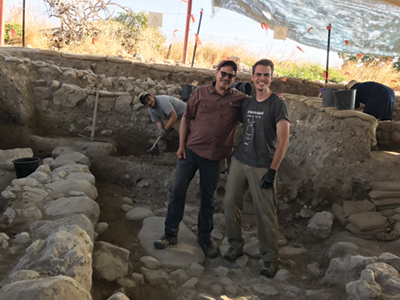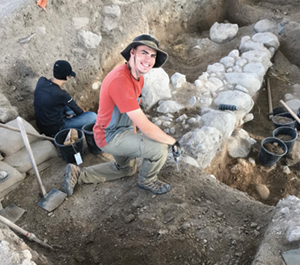Perspectives from a Summer Abroad
During the summer of 2019, J.P. Dessel, associate professor of history, participated in two archaeological excavations. He brought undergraduate student Dillon Wayne with him to Israel. They share their perspectives below.
 “In Georgia, I joined a friend who is excavating a site with evidence for the earliest production of wine. The site, Shulaveris Gora, is located a few hours south of Tbilisi, near the Armenian border, and dates to the Neolithic period, about 6000 BCE. We were excavating beneath the stratum with the earliest wine and quickly came down to the aceramic Neolithic level before reaching virgin soil. Next season, we hope to continue work at a Chalcolithic site that dates to the fifth millennium BCE and might help scholars understand how wine production led to increasing social complexity in the Caucasus. While in Tbilisi, I had a chance to visit the two major synagogues and a small Jewish museum filled with the history of Caucasus Jewry. The Jewish community keeps a pretty low profile, and does not even seem to produce any notable kosher wines.
“In Georgia, I joined a friend who is excavating a site with evidence for the earliest production of wine. The site, Shulaveris Gora, is located a few hours south of Tbilisi, near the Armenian border, and dates to the Neolithic period, about 6000 BCE. We were excavating beneath the stratum with the earliest wine and quickly came down to the aceramic Neolithic level before reaching virgin soil. Next season, we hope to continue work at a Chalcolithic site that dates to the fifth millennium BCE and might help scholars understand how wine production led to increasing social complexity in the Caucasus. While in Tbilisi, I had a chance to visit the two major synagogues and a small Jewish museum filled with the history of Caucasus Jewry. The Jewish community keeps a pretty low profile, and does not even seem to produce any notable kosher wines.
After working in Georgia, I returned to Israel and began work at the site of Tell Abel Beth Ma’acah. Abel is a wonderful site located in the far north of Israel, in tip of “the finger” just south of the town of Metulla on the Lebanese border. The Galilee is one of most of the most beautiful parts of Israel, mountainous, relatively undeveloped, and surprisingly calm. I was invited to join this Hebrew University project in order to work on the Early Bronze Age strata which are just coming into phase. We thought we would easily reach in situ Early Bronze III material, but as is often the case, the site had a few surprises in store for us. As I was removing some extent Middle Bronze II/III (roughly 1900-1600 BCE) walls and surfaces, we found six Middle Bronze Age II jar burials. These are interesting and of increasing scientific importance but they are very time consuming to remove.
We stayed at Kibbutz Kfar Szold in the Jordan Valley. It’s a beautiful kibbutz surrounded by some wonderful archaeological sites like the Roman site of Omrit, Nimrud Castle, and natural wonders like the Tanur waterfalls in the Nahal Iyyon, which feeds the Jordan River, and Mt. Hermon. Fortunately our rooms had air conditioning, as not only does it routinely get into the high 90’s, but it’s also incredibly humid (sort of like Knoxville). I brought one student with me this summer, Dillon Wayne, and plan on bringing a full UT contingent in the future. Hopefully, next summer will be able to reach the Early Bronze III stratum. If anyone is interested in joining us next summer at Tell Abel, please feel free to contact me.
Last fall, I was elected president of the Albright Institute of Archaeological Research in Jerusalem. I served on the board of trustees and as an officer for quite a while. Being president is entirely different — more exciting, but also much more challenging. This summer we had a wonderful faux fourth of July party on July 13th that was well attended by many North American, European, and Israeli archaeologists.
In closing, I wish everyone a very healthy and sweet new year - Shanah Tovah! I want to thank my colleagues and friends at the university and especially the Department of History for their support. Hopefully, now that the chaggim are over maybe it will finally start cooling down.
-Submitted by J.P. Dessel, Associate Professor, Department of History
Student Perspective: A Summer Abroad
 “Israel was never a place I expected to visit, but an unanticipated opportunity arose towards the end of last semester when Professor Dessel extended an invitation to our class to work as volunteers at an archaeological dig in northern Israel for a month over the summer. I jumped at the opportunity. I had never been to the Middle East and I knew nothing about archaeological digs so I was a bit apprehensive, but Dr. Dessel helped to allay my worries, and slowly but surely this trip became a reality. My lack of experience might have initially been a cause for concern, but that didn’t stop me from making new friends and having the time of my life.
“Israel was never a place I expected to visit, but an unanticipated opportunity arose towards the end of last semester when Professor Dessel extended an invitation to our class to work as volunteers at an archaeological dig in northern Israel for a month over the summer. I jumped at the opportunity. I had never been to the Middle East and I knew nothing about archaeological digs so I was a bit apprehensive, but Dr. Dessel helped to allay my worries, and slowly but surely this trip became a reality. My lack of experience might have initially been a cause for concern, but that didn’t stop me from making new friends and having the time of my life.
I never expected working at a dig site to be easy or luxurious, and it wasn’t – it was incredibly hard work. It was also really rewarding. The sunrise from the top of the dig site, Tel Abel Beth Ma’acah, overlooking the Huleh Valley at 5 a.m. every morning never became any less captivating and is something I will always remember. Most days, we would start early and dig until noon to avoid the heat, then have lunch at the kibbutz, and then wash and sort pottery sherds found at the various areas. What I learned through experience was complemented by a ton of informative lectures by different professors and other professionals. Needless to say, there was a lot to do besides dig during my month in Israel. Sometimes we traveled as a group to surrounding excavation sites and points of interest, including the Sea of Galilee, Hippos, Hazor, and Tel Dan, among other places.
It takes a special kind of person to dedicate weeks at a time to digging under the Israeli sun. The people I met were incredible. I worked with people from around the world who are some of the most intriguing and kind people that I’ve ever had the opportunity to know. I am deeply grateful to the University of Tennessee, Dr. Dessel, and Tel Abel Beth Ma’acah Excavations for assisting me in having such a rewarding summer experience.”
-Dillon Wayne, Junior, Biological Sciences